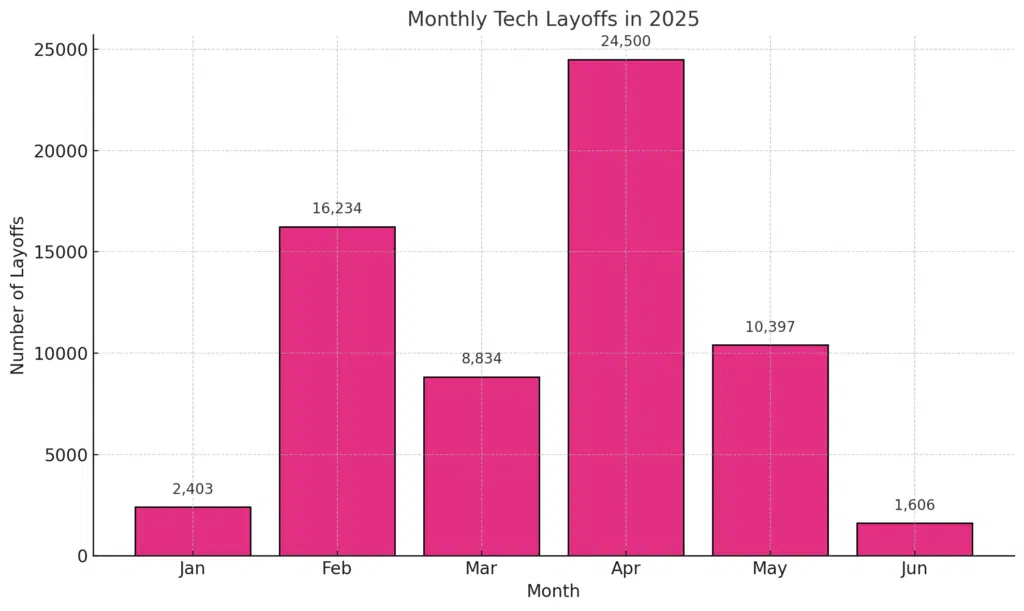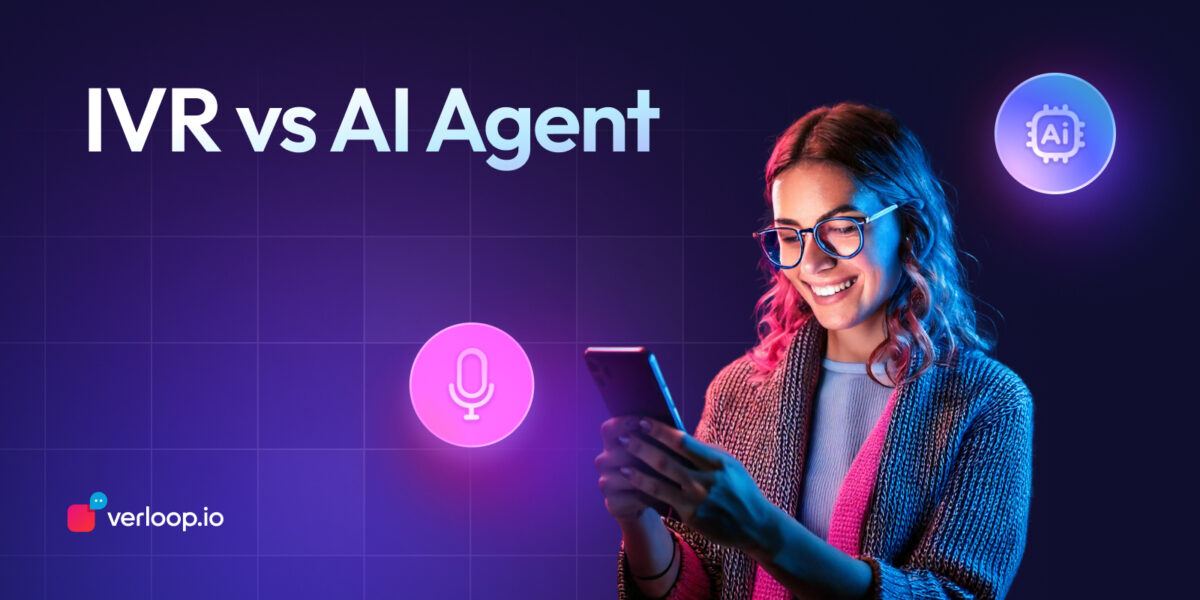
The Cost of Great CX: Can AI Help You Scale Without Spending More?
- August 7th, 2025 / 5 Mins read
-
Aarti Nair
Can You Deliver World-Class CX at Scale While Cutting Costs? The Role of AI
It’s 2025, and the pressure to do more with less has never been higher.
The global economic slowdown is forcing tough decisions across industries—and tech is far from immune. The layoff wave that started in 2022 hasn’t ebbed; in fact, it’s still surging. According to independent tracker Layoffs.fyi, over 150,000 tech employees lost their jobs in 2024 across more than 500 companies. And the trend continues into 2025.
Here’s how the year has unfolded so far:
January: 2,403 tech layoffs
February: 16,234 cuts—making it the worst month yet
March: 8,834 layoffs
April: Over 24,500 layoffs
May: 10,397 layoffs
June: 1,606 layoffs
August, so far: Thousands more are bracing for impact
Even large enterprises are trimming what were once considered essential teams. Atlassian, for example, let go of 150 roles in customer service and support, citing efficiency and long-term sustainability.
For CX and support leaders, this creates a paradox:
How do you deliver world-class customer experience at scale, while cutting costs and reducing headcount?
That’s the impossible ask.
But all is not lost.
Rather than stretching already lean teams thinner, many businesses are turning to AI-powered solutions. Conversational AI, AI agents, intelligent virtual agents, and support automation are no longer future-facing buzzwords. They’re fast becoming the backbone of modern, scalable, cost-efficient CX strategies.
In this blog, we’ll break down how AI is helping brands navigate this challenging moment while balancing speed, personalisation, and cost-efficiency without compromising on customer experience.
Why Scaling CX Has Become So Difficult Now with Traditional Methods?
Today’s customer experience leaders are navigating a high-stakes paradox.
On one hand, customers expect more than ever—personalised service, instant responses, 24/7 availability, and seamless omnichannel interactions. On the other, teams are being asked to deliver all of this with less—smaller budgets, reduced headcount, and tighter resolution times.
This isn’t just anecdotal. It’s strategic.
A recent study reveals that 81% of organisations now view customer experience as a key competitive differentiator. In a crowded market, it’s no longer just about what you sell, but how you support and serve.
Yet despite its importance, CX teams are under-resourced and overstretched. The reality?
You’re expected to deliver world-class experiences at scale, while cutting costs and doing more with fewer people.
Let’s break down the contradiction:
| Customers Want More | CX Leaders Have Less to Work With |
|---|---|
| ✅ Instant & personalised service | 💰 Lower operational budgets |
| ✅ 24/7 availability | 👥 Reduced headcount |
| ✅ Seamless omnichannel experiences | ⏱️ Minimized time to resolution |
This disconnect is what we call “The Impossible Ask.”
Support teams are stuck between rising expectations and diminishing resources—forced to balance quality, speed, and cost without dropping the ball.
So the question becomes: how do you scale exceptional service without breaking the bank or burning out your team?
The answer lies in automation, but not the kind that feels robotic. AI-powered customer support is now stepping in as a viable, scalable, and surprisingly human alternative.
Why Traditional Scaling Fails (and Fast)
When customer expectations surge, the instinctive response is to scale headcount.
Hire more agents. Extend support hours. Add more channels.
It seems logical but in practice, traditional customer service scaling is slow, expensive, and unsustainable.
Let’s break down why it fails and why it fails fast.
1. It’s Expensive by Design
Every new customer support agent adds recurring cost.
According to Callin.io, the average cost of handling a single inbound call ranges between $8 to $15. And if you’re trying to deliver round-the-clock service?
You’re looking at $28 to $38 per representative per hour, based on WorldwideCallCenters.com estimates.
That means scaling your team to meet rising volumes can skyrocket your support costs overnight, especially when you’re expected to do more with less.
2. It Doesn’t Solve the Real Bottleneck
Even the best-trained agents are human. They can only handle one customer interaction at a time. During peak hours, this creates bottlenecks with long wait times, missed chats, and frustrated customers.
Add to that the rising number of channels (WhatsApp, live chat, email, calls), and the pressure mounts.
More queries + limited capacity = slower responses and lower CSAT.
3. It’s Prone to High Turnover
Working in support isn’t just stressful—it’s often thankless.
The customer support industry sees turnover rates between 30–45%, nearly three times the national average, according to Nextiva. Hiring and training replacements is not only time-consuming, but it also leads to knowledge gaps and inconsistent service quality.
High attrition doesn’t just impact team morale—it directly affects the bottom line.
4. It’s Slow to Learn and Improve
Traditional quality assurance processes are labour-intensive and reactive.
It takes 20 to 30 minutes for a manager to manually audit just one conversation. Multiply that across thousands of daily interactions, and it’s no surprise that most insights come too late to make a meaningful impact.
That’s not just inefficient, it’s
- Missed opportunity to coach agents,
- Identify trends, or
- Fix customer pain points in real time.
The result?
Traditional scaling strategies quickly hit a wall:
- High costs,
- Burnout,
- Bottlenecks, and
- Delayed improvements.
It’s not that your team isn’t capable. It’s that the model they’re working within is no longer built to scale.
So, how do you deliver seamless, personalised, 24/7 support, without multiplying costs and headcount?
This is where AI-powered customer experience begins to shine.
The AI Promise: Scale Smart, Not Big
When conversations around automation come up, there’s often an immediate pushback:
“But we already invested in automation.”
“We have a chatbot.”
“Our IVR system handles most of the calls.”
And yes—those systems were a step in the right direction.
But they were built for yesterday’s customer and yesterday’s expectations.
Legacy automation—rule-based chatbots, IVRs, and static self-service portals—was designed primarily with internal cost-saving goals in mind, not customer experience. They were built to deflect, not to delight.
Let’s be honest—how often have you heard someone say:
“I love talking to that IVR system,” or “That FAQ bot solved everything!”?
Exactly.
The Problem with Legacy Automation
1. It’s Static and Scripted
Rule-based bots don’t understand nuance. They follow decision trees. The moment a customer strays from a predefined path, the bot breaks or worse, loops endlessly.
2. It’s Detached from Context
Legacy systems treat every interaction as a new one. There’s no memory of past tickets, preferences, or context—forcing customers to repeat themselves and wasting agent time when escalation is needed.
3. It’s Siloed and Channel-Limited
IVRs live on phones. Self-service portals sit on websites. None of these tools talk to each other—let alone integrate with modern CRM systems, analytics platforms, or agent assist tools.
4. It Doesn’t Scale Well
You might have 10,000 users on your site, but your rule-based automation can’t dynamically prioritise, route, or personalise responses at that scale. That means every interaction is generic, and opportunities for upsell, loyalty, or resolution are lost.
Enter the New Age of AI-First CX
Modern conversational AI, powered by generative models, isn’t just smarter—it’s fundamentally different.
It doesn’t rely on rigid scripts. Instead, it uses natural language understanding (NLU), context retention, and real-time decision-making to hold meaningful, human-like conversations. Whether it’s via chat or voice, AI agents can resolve queries, personalise responses, and even perform actions—without manual intervention.
And unlike legacy automation, these AI systems learn and improve over time—becoming more accurate, empathetic, and efficient with each interaction.
So instead of scaling by hiring more humans—or adding more layers of clunky automation—forward-thinking companies are scaling with intelligence.
They’re using AI to:
Resolve 60–80% of Tier-1 queries instantly
Reduce response times by 70%
Personalise customer journeys without manual tagging
Improve CSAT and lower operational costs by 50%.
And they’re doing it without sacrificing quality, empathy, or efficiency.
What AI-Powered CX at Scale Looks Like
AI in CX isn’t some future fantasy—it’s already reshaping how businesses operate today. And as investment signals from analysts show, that transformation is only accelerating.
Across industries, we’re seeing a decisive move away from manual resolution and rigid automation towards AI-powered agents that are intelligent, context-aware, and action-oriented.
Let’s break down what this shift looks like on the ground.
AI in Action: Beyond Just Bots
Retail brands are using AI agents to provide real-time assistance—handling FAQs, processing returns, and making product recommendations based on browsing history or past purchases.
Healthcare providers are deploying multimodal AI assistants for appointment scheduling, post-visit instructions, and symptom triage—freeing up front desk staff and reducing missed appointments.
Banks and fintech platforms are integrating voice AI agents that handle routine inquiries like balance checks, fraud alerts, and even KYC processing—all without wait times or handoffs.
And this change isn’t just anecdotal—it’s backed by industry forecasts:
According to Gartner and Statista:
70% of call centre agent tasks will be automated by virtual assistants by 2026
80% of businesses plan to adopt AI-driven voice tech for customer service operations by 2026
50% of business decisions will be augmented or automated by AI agents by 2027
60% of dashboards will be replaced by GenAI-powered narratives by 2028
These aren’t fringe predictions—they reflect a strategic shift happening across enterprise CX stacks right now.
What Makes AI So Effective at Scale?
Modern AI-powered systems solve the very problems that traditional models created:
They learn from past conversations to improve future ones
They respond in real time—even across multiple channels simultaneously
They can handle thousands of queries at once without breaking or bottlenecking
They integrate deeply with your tech stack—CRMs, ticketing systems, product databases
And most importantly, they don’t just answer questions—they take action.
From processing refunds to rescheduling deliveries or escalating urgent issues, AI agents are moving from reactive to proactive.
So while human support will always have a role, AI is quickly becoming the front line for filtering, resolving, and enhancing every interaction at scale.
In the next section, we’ll explore how companies can get started, and what it takes to implement AI in a way that aligns with your CX goals and operational realities.
Where We Stand with AI Maturity in 2025 — And What It Means for CX at Scale
In 2025, AI has moved past novelty.
Most businesses are no longer asking if they should explore AI—but how far they’ve come in implementing it meaningfully.
And that’s where AI maturity becomes the deciding factor.
According to Gartner’s AI Maturity Model, companies are distributed across five levels—from basic awareness to full-scale transformation. But here’s the catch: most organisations in 2025 are stuck somewhere between Level 2 (Active) and Level 3 (Operational).
| Level | Stage | Description |
|---|---|---|
| 1 | Awareness | AI is discussed informally, but not explored through pilots or strategy. |
| 2 | Active | Pilot projects begin. Focus is on experimentation, often led by data teams. |
| 3 | Operational | AI is deployed in production. Dedicated teams and budgets exist. |
| 4 | Systemic | AI is embedded into digital products, services, and process designs. |
| 5 | Transformational | AI becomes part of business DNA—driving value across every layer of the org. |
They’re experimenting with AI. Maybe they’ve launched pilot projects, deployed a chatbot, or tried out an LLM for marketing content. But for the majority, AI is still siloed, inconsistent, and far from business-critical.
What does that mean in practical terms?
AI is still largely experimental or departmental, not enterprise-wide.
Many teams are running isolated pilots, often without strategic alignment.
AI adoption is driven by individual teams or innovation units, rather than core business functions.
Feedback loops between AI outputs and business decisions are still inconsistent.
In other words, AI is present—but not yet powerful.
The Stakes of Staying Static
This fragmented maturity comes at a cost—especially for CX leaders under pressure to scale efficiently.
Companies that remain stuck in early-stage maturity risk:
Lagging behind on AI-driven efficiencies, while competitors automate at scale
Failing to meet customer expectations for real-time, personalised service
Missing early mover advantages in adopting AI voice, generative agents, and intelligent triage
Struggling to justify AI ROI due to incomplete implementation or siloed results
And perhaps most critically—they miss the window to shape AI responsibly within their workflows, before it’s imposed top-down later.
What’s Next: The Shift from “Trying AI” to “Becoming AI-Ready”
As the AI landscape matures, the conversation is shifting from isolated tools to ecosystem readiness:
Do your teams have access to the right data and know how to use it?
Are your internal systems ready to integrate with intelligent agents?
Is AI embedded into workflows, or is it still something “on the side”?
Are compliance, auditability, and rollback mechanisms in place?
Most importantly, do you have a clear strategy—not just a wishlist?
This is what separates businesses that scale AI with confidence from those that simply chase trends.
AI Maturity Is a Cost Strategy
There’s a growing realisation that advancing AI maturity isn’t just about innovation—it’s about cost control.
Higher maturity allows you to:
Automate intelligently across workflows (not just deflect queries)
Reduce dependency on manual QA and task routing
Build adaptive, responsive CX systems that don’t need constant reconfiguration
Turn AI from a side project into a core operational engine
In other words, AI maturity determines how much ROI you can actually realise from your AI investments—and how fast you can get there.
AI Agents in 2025: Expectations vs. Reality
The tech media has crowned 2025 the “Year of the AI Agent”—and the hype is hard to miss. From orchestrated multi-agent systems to autonomous assistants managing workflows end-to-end, the vision is clear: AI agents will transform how work gets done.
But where does this vision stand today? And more importantly—for support, ops, and CX teams—how much of it is ready for deployment?
What’s an AI Agent, Really?
At its core, an AI agent is an autonomous system that can understand goals, plan, and execute tasks—often using Large Language Models (LLMs) and APIs. Unlike traditional bots or assistants that need constant prompting, agents can break down high-level instructions and act independently (within limits).
In theory, you could say: “Reconcile all refund requests this month, flag anomalies, and send a report.” The agent figures out the rest.
But in practice, 2025’s agents are still early prototypes—intelligent enough to automate workflows, yet far from being fully autonomous decision-makers.
Expectation: Agents Will Handle Complex Tasks Solo
Reality: Most can’t—yet.
While current agents can trigger tools and string together tasks using “function calling,” they still struggle with edge cases, ambiguity, or contextual handoffs. They’re brilliant at well-defined processes—but brittle in messy real-world scenarios.
This is especially crucial in CX: agents might auto-respond to shipping queries or track orders, but fail to triage nuanced complaints or escalate high-risk cases without manual oversight.
Expectation: Agents Will Slash Operational Costs
Reality: Only when systems are agent-ready.
As IBM Distinguished Engineer Chris Hay notes,
“Most organisations aren’t agent-ready. What’s going to be interesting is exposing the APIs that you have in your enterprises today… That’s not about how good the models are going to be. That’s going to be about how enterprise-ready you are.”
This underscores a critical point: agent ROI depends less on model intelligence and more on system maturity. Until internal tools, workflows, and data pipelines are accessible to agents, operational gains will be limited.
Expectation: Orchestration will solve the maturity gap
Reality: Not always.
Some believe orchestrators—meta-agents that govern networks of other agents—are the answer. But that’s not always necessary or practical. In many use cases, individual agents can already self-coordinate, call the tools they need, and complete simpler tasks.
For complex enterprise use, agent-plus-human collaboration (human-in-the-loop) is more realistic than building large, multi-agent ecosystems from day one.
So, What Should Businesses Do in 2025?
Here’s a grounded approach to adopting AI agents:
Start with predictable, low-risk tasks like summarising chats, extracting order details, or tagging conversations.
Identify repetitive workflows with clearly defined triggers and outcomes. These are agent-friendly zones.
Invest in backend readiness: APIs, clean data, access controls, observability layers. This is where real agent ROI is unlocked.
Pair agents with humans to catch errors, review critical steps, and provide ethical guardrails.
Design rollback mechanisms and audit logs. Agents need fail-safes, not just autonomy.
Why It Still Matters—Even If We’re Not Fully There
Despite the gap between expectation and reality, AI agents signal a fundamental shift in how CX operations will scale:
Faster handling of repetitive tasks
Round-the-clock support without burnout
Personalised interactions with real-time context
Significant cost reduction when deployed at scale
Reduced dependency on manual rule-based systems
But the payoff depends entirely on how grounded your approach is. Early wins don’t come from “autonomous magic,” but from building layered intelligence—step by step.
Should You Wait or Adopt AI Agents Now?
| Category | Waiting to Adopt | Adopting AI Agents Now |
|---|---|---|
| Customer Experience (CX) | Reactive support, inconsistent quality, long response times | Faster, 24/7 personalised support across channels |
| Cost of Operations | Continues to rise with volume and hiring | Reduced cost-per-interaction and headcount dependence |
| Agent Productivity | Repetitive, manual tasks dominate workload | Agents focus on complex issues; AI handles routine at scale |
| Speed to Resolution | Slower due to bottlenecks and one-agent-per-task limitations | Parallel query handling; auto-resolution for common issues |
| CX Data Insights | Manual QA, limited visibility | Real-time insights, continuous learning, automated audit trails |
| Competitive Edge | Risk of falling behind to AI-mature competitors | Early mover advantage in automation and experience design |
| Employee Morale | High burnout, turnover from repetitive work | Higher retention through intelligent task allocation |
| Scalability | Linear scaling (more demand = more agents = higher cost) | Non-linear scaling with AI handling increased volume efficiently |
| Technology Readiness | Risk of AI fatigue and rushed adoption later | Steady integration into current systems with a maturity roadmap |
| Time-to-Value | Delayed ROI and missed opportunities | Faster feedback loops, measurable efficiency gains now |
The difference is clear: waiting means reacting, while adopting now means preparing.
By delaying AI agent adoption, businesses risk being caught in the same old cycle—manual effort, rising costs, and overstretched teams. Meanwhile, competitors who move early are reaping the benefits: faster service, lower overheads, and scalable customer experiences.
But here’s the catch: not all automation delivers the promised value.
Many companies think they’ve already “done automation” with chatbots and IVRs but these legacy systems were built for containment, not conversation.
Scaling CX Without Losing the Human Touch – Where to Start
For businesses ready to begin—or accelerate—their AI journey, the key is intentional implementation. This isn’t about replacing humans or deploying AI everywhere at once. It’s about finding high-impact use cases, building confidence, and scaling smart.
Here’s how to start:
Prioritise High-Volume, Low-Complexity Use Cases
Look at the repetitive queries that clog your support queue daily—order status, password resets, appointment confirmations. These are prime candidates for automation with minimal risk and high ROI.
Layer AI + Human Handoff
Not every conversation can—or should—be resolved by an AI agent. Build a system where AI handles the initial triage, and complex or emotional cases are handed over to human agents seamlessly, with full context. This is how you maintain trust while boosting efficiency.
Use AI for Agent Assist, Not Just Deflection
AI isn’t just for customer-facing automation. It can support your agents in real time—surfacing past interactions, recommending replies, summarising chats, and flagging priority tickets. This helps agents work smarter, not harder.
Evaluate ROI Regularly
Don’t set it and forget it. Track metrics like resolution time, cost per ticket, CSAT, and AI containment rate. Use these insights to fine-tune your AI workflows and justify further investment.
AI Isn’t Just a Cost-Cutter — It’s a CX Amplifier
For too long, automation in customer support was treated purely as a cost-cutting tool—measured by how many agents it could replace or how much time it could shave off.
But that mindset is changing.
With the rise of mature, intelligent AI agents, businesses are discovering that AI isn’t just cheaper—it’s often better. It responds instantly. It never forgets. It scales without burnout. And when implemented well, it doesn’t diminish the customer experience—it enhances it.
The impossible ask of delivering world-class CX at scale while cutting costs?
It’s not impossible anymore.
It just requires a different approach.
With the right strategy, governance, and maturity, AI becomes more than automation—it becomes a competitive advantage.
Now’s the time to move from exploration to execution.
Because while others are still asking “if,” leaders are already asking, “Where else can we apply it?”
Learn how AI agents can transform your support stack—without sacrificing the human touch.
Book a free demo
FAQs
1. What is AI maturity, and why does it matter for customer experience?
AI maturity refers to how advanced an organisation is in adopting and integrating AI across operations. Companies with higher AI maturity can deliver better customer experiences at lower costs by automating processes, reducing manual workload, and personalising at scale.
2. Why do traditional customer support models struggle to scale?
Traditional models rely heavily on human agents, leading to high costs, limited capacity, and slow response times. Issues like agent burnout, 30–45% annual turnover, and the inability to manage growing support volumes make scaling inefficient without automation.
3. Haven’t businesses already implemented automation? Why isn’t it enough?
Many companies have legacy automation like IVRs, outdated chatbots, or static FAQs focused solely on cost-cutting. These tools often lack intelligence and contextual understanding, leading to poor CX. Generative AI brings a new layer of adaptability and learning to automation.
4. What’s the difference between AI agents and traditional chatbots?
Traditional chatbots follow pre-set scripts and can’t handle complex queries. AI agents, powered by LLMs, can understand, reason, and act autonomously—handling nuanced conversations, integrating with backend systems, and executing tasks with minimal human input.
5. Is now the right time to invest in AI agents for customer support?
Yes. Early adoption gives companies a competitive edge by reducing operational costs and improving CX. With advancements in AI agent capabilities and falling model costs, waiting may increase the cost of entry and put customer loyalty at risk.
6. How can businesses get started with AI in customer support?
Begin with an AI maturity assessment, identify high-impact use cases (e.g. handling FAQs, voice-based ticketing, quality audits), pilot with AI agents in those areas, and scale gradually. Invest in good data practices, governance, and team readiness.
7. Will AI agents replace human agents?
Not entirely. AI agents will handle repetitive and predictable tasks, allowing human agents to focus on complex, emotional, or high-value interactions. This human-AI collaboration improves both efficiency and customer satisfaction.
8. How do AI agents help reduce customer support costs?
They handle multiple conversations simultaneously, reduce first response time, automate ticket routing and resolution, and lower the need for 24/7 staffing. This significantly brings down the cost per resolution compared to traditional voice or email support.









